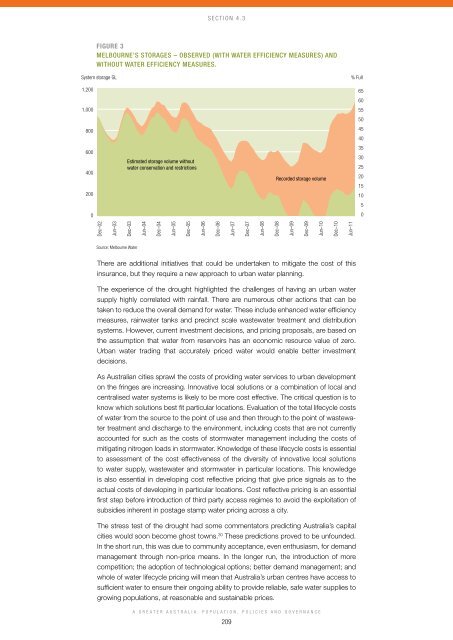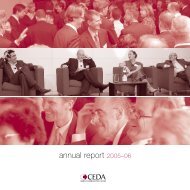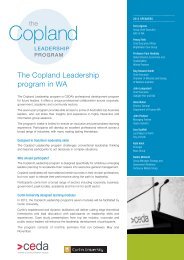A Greater Australia: Population, policies and governance - CEDA
A Greater Australia: Population, policies and governance - CEDA
A Greater Australia: Population, policies and governance - CEDA
- No tags were found...
You also want an ePaper? Increase the reach of your titles
YUMPU automatically turns print PDFs into web optimized ePapers that Google loves.
Section 4.3Figure 3Melbourne’s storages – observed (with water efficiency measures) <strong>and</strong>without water efficiency measures.System storage GL% Full1,20065601,00055508004540600400Estimated storage volume withoutwater conservation <strong>and</strong> restrictionsRecorded storage volume353025201520010500Dec–02Jun–03Dec–03Jun–04Dec–04Jun–05Dec–05Jun–06Dec–06Jun–07Dec–07Jun–08Dec–08Jun–09Dec–09Jun–10Dec–10Jun–11Source: Melbourne WaterThere are additional initiatives that could be undertaken to mitigate the cost of thisinsurance, but they require a new approach to urban water planning.The experience of the drought highlighted the challenges of having an urban watersupply highly correlated with rainfall. There are numerous other actions that can betaken to reduce the overall dem<strong>and</strong> for water. These include enhanced water efficiencymeasures, rainwater tanks <strong>and</strong> precinct scale wastewater treatment <strong>and</strong> distributionsystems. However, current investment decisions, <strong>and</strong> pricing proposals, are based onthe assumption that water from reservoirs has an economic resource value of zero.Urban water trading that accurately priced water would enable better investmentdecisions.As <strong>Australia</strong>n cities sprawl the costs of providing water services to urban developmenton the fringes are increasing. Innovative local solutions or a combination of local <strong>and</strong>centralised water systems is likely to be more cost effective. The critical question is toknow which solutions best fit particular locations. Evaluation of the total lifecycle costsof water from the source to the point of use <strong>and</strong> then through to the point of wastewatertreatment <strong>and</strong> discharge to the environment, including costs that are not currentlyaccounted for such as the costs of stormwater management including the costs ofmitigating nitrogen loads in stormwater. Knowledge of these lifecycle costs is essentialto assessment of the cost effectiveness of the diversity of innovative local solutionsto water supply, wastewater <strong>and</strong> stormwater in particular locations. This knowledgeis also essential in developing cost reflective pricing that give price signals as to theactual costs of developing in particular locations. Cost reflective pricing is an essentialfirst step before introduction of third party access regimes to avoid the exploitation ofsubsidies inherent in postage stamp water pricing across a city.The stress test of the drought had some commentators predicting <strong>Australia</strong>’s capitalcities would soon become ghost towns. 30 These predictions proved to be unfounded.In the short run, this was due to community acceptance, even enthusiasm, for dem<strong>and</strong>management through non-price means. In the longer run, the introduction of morecompetition; the adoption of technological options; better dem<strong>and</strong> management; <strong>and</strong>whole of water lifecycle pricing will mean that <strong>Australia</strong>’s urban centres have access tosufficient water to ensure their ongoing ability to provide reliable, safe water supplies togrowing populations, at reasonable <strong>and</strong> sustainable prices.A <strong>Greater</strong> <strong>Australia</strong>: <strong>Population</strong>, Policies <strong>and</strong> Governance209





